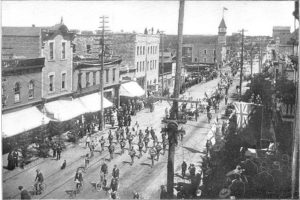Rat Portage

Upon his arrival on July 22nd, Du Vernet could not help but comment on the late night beauty of Rat Portage. A scenic town at the northern end of the Lake of the Woods, Rat Portage owed its curious name to its Indigenous history: the Ojibwe called the area Waszush Onigum, the portage to the country of the muskrats. In the early nineteenth century, the Hudson’s Bay Company borrowed the name for a fur trading post, which was then located on Old Fort Island on the Winnipeg River. When the post was relocated to the mainland and a town grew around it, the community adopted Rat Portage as its name.
Treaty 3
In 1873, Ojibwe Chiefs signed Treaty 3 with the Crown, believing they were entering a resource sharing agreement with the Canadian government. But the government soon appropriated Ojibwe land and waterways in the interest of white settlements and large-scale resource exploitation, mainly in mining and forestry. Rat Portage acted as a regional services and transportation hub for furthering these colonial interests. For more information on the Ojibwe surrounding Rat Portage in the Lake of the Woods region, see the Lake of the Woods article.
The Railway and Other Changes
Rat Portage soon became caught in a fierce territorial dispute between Ontario and Manitoba, with both provinces vying for jurisdiction. While Ontario would ultimately claim Rat Portage, the town was already changing in more subtle ways. As its population grew in size, new businesses arose, lessening the importance of the fur trade and the presence of the Hudson’s Bay Company in the town. No longer primarily a fur trading establishment, Rat Portage took on new life in the 1870s when it was connected to the continental railway. The timber industry boomed as lumber was sought for railway stations, warehouses and new residences. But the drive for lumber also resulted in environmental degradation of the forests and the river; numerous logs, transported by water, were lost in the Lake of the Woods.
By the beginning of the twentieth century, the logging industry, like the fur trade before it, was on the wane. The railroad was complete and so timber was no longer in as great demand. But the town transformed itself once more, becoming a major tourist destination. With Canadian Pacific trains running on regular schedules, Rat Portage became a destination for fishers, and with the discovery of gold near Rat Portage, gold prospectors.
By Any Other Name
In 1905, Rat Portage amalgamated with the neighbouring towns of Keewatin and Norman. Soon after, Rat Portage was renamed, together with Keewatin and Norman, as the town of Kenora, which it remains to this day. The renaming did not go without controversy, with one resident decrying that the town’s old name was truer to Rat Portage’s early days, when “dead muskrat [were] found at the foot of our falls” by fur traders who had “eyes to see and noses to appreciate.”
Today, the forest industry has declined in Kenora, with the town’s pulp and paper mills closing down in 2005. The town is still predominately inhabited by settlers, but Indigenous peoples from surrounding reserves have moved to Kenora in greater numbers in recent years.